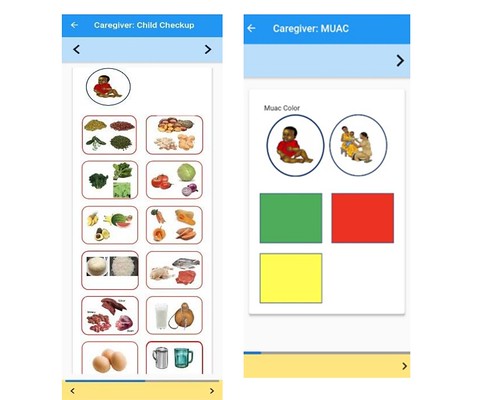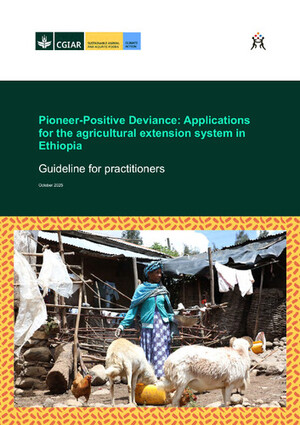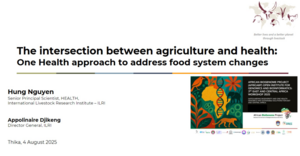
Project work amid the COVID-19 pandemic: Updating the household nutrition data collection app in Samburu
Written by Watson Lepariyo,
Research Associate, International Livestock Research Institute
In October 2019, International Livestock Research Institute (ILRI) in partnership with the Food, Agriculture and Natural Resources Policy Analysis Network (FANRPAN) launched a one-year pilot study in Kenya’s Samburu County as part of a larger project to develop and test low-cost data collection tools for assessing the nutrition status of households in Kenya’s pastoral areas.
These tools are integrated into a mobile phone application (app), which is known as ‘Mbiotisho’ (our health), that is used by households members who have no formal education, to record and track indicators of their own health and nutrition status in near real-time basis. Users receive individualized feedback on the indicators of nutritional progress against the international standards for those indicators. By April 2020, 22 community health volunteers (CHVs) and 189 caregivers from four community health units (CHUs) in Samburu were using the app.

Participants from the Lorubae Community Health Unit in Samburu County, December 2019 (photo credit: ILRI/Watson Lepariyo).
But managing the project’s fieldwork amid the COVID-19 pandemic, which is affecting day-to-day life in much of the world, has been both challenging and exciting. Generally, the implementation of field activities in development projects is affected by many unforeseen events. Finding workarounds to these challenges requires flexibility and creative solutions from project teams and partners. But the measures that have been put in place to curb the spread COVID-19 in Kenya, including restrictions on movement and a ban on public gatherings of more than a few people, are changing fieldwork as we know it. Researchers and project implementers will need to rethink the ways in which they can continue to carry out project activities and share information and knowledge during the pandemic.
The first version of the app was pre-tested in July 2019. Since then, the ‘Improving dietary and health data for decision-making’ project team has continued to further develop the app through an iterative cycle (of deploy, receive feedback, improve, and deploy) with the users to improve its functionality and user experience.
In response to feedback from caregivers, the team developed a set of in-app reports on diet diversity and antenatal care that compare caregivers’ own recorded information against international standards of nutrition indicators and provide the caregivers with feedback on the indicators. Like in other components of the application, the caregivers record their information and access the reports through icons and pre-recorded audio messages within the app. Feedback is provided to the caregivers on their performance through the same interface.

Selected screenshots of the feedback provided to caregivers, which is done using pre-recorded audio messages (photo: ILRI).
After testing the new features (i.e. updating the caregiver report template and redeploying the application) the research team was looking forward to explaining the updated app to the caregivers and seeing their reactions to the new feature. Before the COVID-19 pandemic, one-day training events on interpreting the reports and installing the updated application were planned for mid-May, in four locations (Wamba, Lorubae, Lolkuniyiani and Lodung’okwe) in Samburu east. Unfortunately, these events have not been held because of the ban on public gatherings that is currently in place to manage the spread of COVID-19 in Kenya.
The team has been busy rethinking the project approaches to ensure that we can maintain the existing data collection exercise. We have also been exploring new methods of re-deploying the application with the new features under the current conditions.
Some of the project administration work, such as troubleshooting the app or sending airtime to participants, can be performed remotely. But updating the application remotely for users who have no formal education, have poor internet connectivity and little experience using smartphones is a significant challenge.
Executing a remote update successfully requires prior meticulous planning and a customized solution for the specific (pastoral) context of users. At this time, creating an instructional video of the steps the users need to follow to update the app seems to be the most suitable solution to this challenge. This option is best because the video can be produced in the local language and include screenshots and voice explanations to walk the user through the process of updating the app. Further, the video can be created at a relatively low cost with readily available resources and software. For example, Using MS PowerPoint, we have created an interactive video that explains (in Kiswahili) the process of updating the app. To address the challenge of poor internet connectivity, we shared a URL of the video via WhatsApp with the participants, which allowed them to download it on their smartphones and watch it at their convenience.
Finally, we were ready to launch the update. The update process went smoothly, apart from a few hiccups, where some of the settings of the participants devices were jumbled up and the participants could not apply the standard procedures to update the app. For those affected, we recreated the scenario and walked them through the process on a phone call.
Even though the pandemic has halted the face-to-face interactions that would enable the use of more straightforward processes, through teamwork and use of technology-based solutions, we have been able to successfully deploy the update to the ‘Mbiotisho’ app.
Edited by Sarah Kasyoka and Paul Karaimu.




















